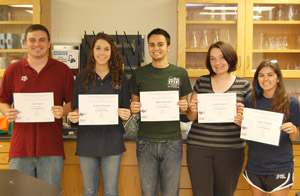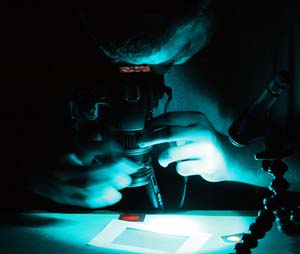
Texas A&M students who earned the Forensic Technician certificate were (pictured l-r): Alex Weghorst, Kortney Parchman, Madison Gaytan, Alyssa Laymance, and Lindsey Thompson. Photo by Rob Williams.
Five students are now official Forensic Technicians as they completed the Texas Forensic Science Academy’s latent fingerprint class this May.
Students Alex Weghorst, Kortney Parchman, Madison Gaytan, Alyssa Laymance and Lindsey Thompson received their certifications after completing workshops in latent print processing and crime scene investigation techniques.
The course, which was led by TFSA Coordinator Christine Ramirez, is cross-listed in the Texas A&M catalog as FIVS422 under the Forensic and Investigative Sciences Program, and students earn 2 semester hours of college credit. To earn the Forensic Technician certificate, students must complete the 40-hour Crime Scene Investigation and 40- hour Latent Print Processing courses.
The two courses provide participants with information, techniques, and methodologies for conducting crime scene investigations and processing crime scene evidence. Completion of this certification is equivalent to completion of the FSA106 – Crime Scene Investigation and FSA104 – Latent Print Processing courses.

Alex Weghorst setting up a camera to photograph a print. Photo by Rob Williams.
Offered through the Texas Forensic Science Academy, the certification program offers science-based, application-intensive, forensic training designed for law enforcement professionals and non-commissioned personnel responsible for crime scene investigations.
Topics covered include crime scene searches, scene documentation, handling evidence, latent print processing and print processing from blood, as well as with conventional and fluorescent powders.
The training is part of the Texas Forensic Science Academy, a collaboration between Texas A&M’s Forensic and Investigative Sciences Program and TEEX as a way of training law enforcement professionals and non-commissioned personnel responsible for either processing and investigating crime scenes or handling evidence used in preparing criminal cases.
Students learned different basic techniques for processing latent fingerprints and enhancing visible prints from crime scenes. They also received instruction in taking and processing prints from physical evidence collected from the scene.
“Both courses were great,” Parchman said. “The latent print course was great and was more hands-on.”
“The students did very well,” Ramirez said. “They are a very enthusiastic and motivated group and doing very exceptional work.”
Senior forensics major Lauren Garmley loved that the course was hands-on and learning about working with latent fingerprints.
“It’s a great opportunity to explore my future career options,” she said.
Senior Jennifer Rhinesmith said the fingerprint course, as well as being certified would be a plus in helping to find a career. “The best thing about this course is the hands-on experience,” she said. “Christine’s experience has been very valuable.”
Rhinesmith plans on taking the Crime Scene Investigation course that will be offered in January 2013.
The Forensic and Investigative Sciences degree program at Texas A&M prepares students for careers that involve the collection, preservation, processing and use of evidence and information to solve problems. These careers include law, medicine, homeland security, public safety, political science, environmental quality, agriculture, public health, chemistry, anthropology, physics, computer science and business.
The Department of Entomology enjoys its partnership with TEEX’s Texas Forensic Science Academy. This partnership between faculty and students of TAMU’s Forensic and Investigative Sciences program and experts from TEEX’s Forensic Science Academy will strengthen the curriculum at Texas A&M and offer students an opportunity to participate in cutting-edge technologies and current field methods.